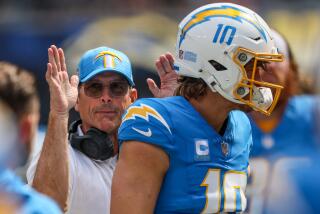Johnnie Gray is a stickler for NFL professionalism
- Share via
From Green Bay, Wis. — While the Green Bay Packers and Buffalo Bills warmed up before a game last month, a solitary figure stood off to the side, passing judgment on how they were dressed.
Scribbling his findings into a notebook, Johnnie Gray kept his eyes peeled for untucked jerseys, bare midriffs and unauthorized footwear, among other breaches of a strict dress code.
The former Packers safety from Lompoc High and Cal State Fullerton counts himself among a 32-man crew entrusted to maintain the rigid sartorial sanctity of the NFL.
He is a uniform inspector.
A friend calls him a narc.
Gray, 56, laughs it off.
“People like to say it’s the No Fun League and yada, yada,” he says, more amused than exasperated. “But you know what? Just follow the rules. That’s all it is. This is not an opportunity to display how you look; it’s an opportunity to display your talent.”
The NFL’s aim is to maintain a level of professionalism — and to protect its multimillion-dollar business partners.
“Everything that’s worn on game day has to be licensed by the National Football League,” Gray notes. “You see the Gatorade buckets, the Wilson footballs, Reebok apparel [and] different brands of shoes that are licensed by the league.”
And, if Gray does his job right, that’s all you’ll see.
Everyone and everything in view of the cameras and involved with the game — coaches, players, ball boys, telecommunications equipment, medical staff, trainers, etc. — is in play.
“This is not college, where guys wear their jerseys halfway down to their belly button,” Gray says. “This is about being professional, maintaining a look — and it’s also about marketing. These companies are paying tons of money.”
Before last month’s game at Lambeau Field, a Bills equipment manager asked Gray whether his shoes passed muster.
The inspector said no.
“You’re a stickler,” the man told Gray, laughing as he ran off to cover his shoes in tape and conceal an offending logo.
Each team’s uniform inspector — all are former NFL players — works his club’s 10 home games, including exhibitions. They fill out three forms — one after warmups, one in the first quarter and one after the game — to log infractions, which could lead to fines starting at $5,000 for something such as a sock pulled too high or low.
“It’s not a hard job,” Gray notes. “You’re not directly confronting players. You’re just making them aware of the rules.”
Gray, a late bloomer, once walked in their shoes.
Growing up, he says, he wanted to be a baseball player and had no interest in football. (His teammates on a Babe Ruth League team, Gray notes, included a first baseman named Ed Rodgers, father of Packers quarterback Aaron Rodgers.)
Grays says it wasn’t until the summer before his senior year, after he’d twice been cut from his high school baseball team, that he took his mother’s advice and tried out for football.
Because he’d never played the game, he was allowed to suit up for the junior varsity as a senior. On the varsity, he played only on special teams, but that was enough to warrant an invitation to play at Allan Hancock College, where he performed well enough to land a scholarship to Cal State Fullerton.
As an undrafted rookie with the Packers in 1975, the 5-foot-11, 185-pound Gray moved into the starting lineup during training camp, replacing a veteran named Jim Hill, who would soon launch a successful broadcasting career in Los Angeles.
Gray was a nine-year starter for the Packers, intercepting 22 passes in 124 games before retiring in 1983.
Today, he walks with a limp.
“Football knees,” Gray says, leaning against a wall whenever possible. “I was going to have them replaced this year, but I decided to wait until after the Packers win the Super Bowl.”
A grandfather, he lives in De Pere, Wis., and works as an instructional aide at a school for cognitively disabled children.
Until this year, Gray also was host of a twice-weekly sports talk radio show, but the Packers asked him to stop airing his opinions when they added him to their board of directors.
He still provides training-camp updates to a local TV station and, on game days, is host of a one-hour pregame radio show.
About 90 minutes before kickoff, he joins the fashion police.
His job is not to enforce the dress code but rather to make note of violations so they can be corrected.
“The inspector helps the player not get fined,” Akil Coad, the NFL’s manager of football operations, says from New York. “He’s there for the players. Listen to him, they won’t get fined.”
A successful inspector, Coad notes, “is one that knows not to be too intrusive … and one that knows the rules.”
And his jurisdiction extends even to the locker room, where Gray lingers through postgame interviews. No logos of unlicensed products are to be seen on players appearing on camera.
Gray stands behind the cameras, motioning to players to remove offending headgear or other apparel.
Sometimes, they ignore him.
Daryn Colledge, a Packers guard and Alaska native, wears a cap celebrating his home state. Gray catches his eye and motions for him to remove it, but Colledge doesn’t budge.
When the cameras are gone, Colledge assures Gray that he saw him but indicates he wanted to keep the cap in place.
Gray says he understands.
Later, he’ll write him up.
jerome.crowe@latimes.com
More to Read
Go beyond the scoreboard
Get the latest on L.A.'s teams in the daily Sports Report newsletter.
You may occasionally receive promotional content from the Los Angeles Times.










